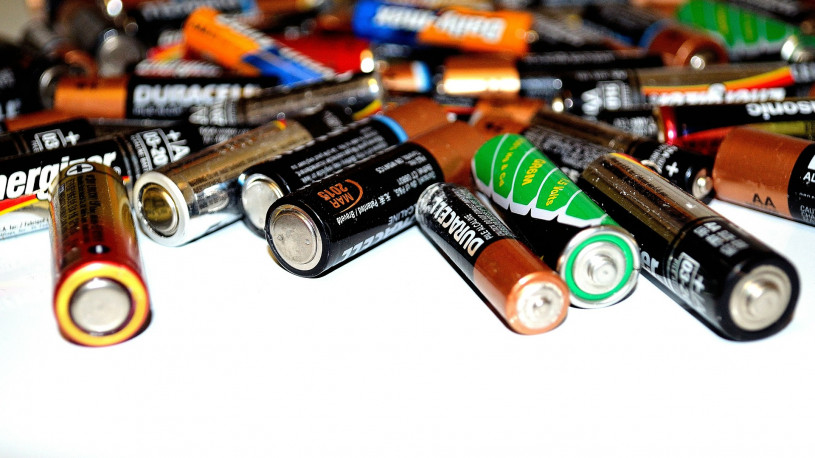-
The Invention of a Self-Destructing Dissolving Battery
 Continue Reading
Continue ReadingScientists from the University of Iowa have developed a water soluble battery that is able to deliver a charge capable of powering a desktop calculator for 15mins. The charge is 2.5 V. The battery dissolves in water in 30 minutes.
The discovery is being held as a major leap forward in the field of transient electronics, an area of research that for years has been trying to make temporary electronic devices that self-destruct or dissolve when a trigger is applied.
Whilst a major breakthrough was made last year with the development of water soluble silicon, many transient electronic devices still needed an external non-transient power source. Attempts to create a transient battery have until now been unsuccessful, as researchers had been unable to develop one that could, as the online journal Futurism reports, “demonstrate the power, stability and shelf life for practical use”.
As the research team outline in their report, published in the Journal of Polymer Science; Part B Polymer Physics, previous efforts have included, “a swallowable battery based on Zn and Pt electrodes and ceramic porous separator [with a] maximum potential of 0.42 V and current of 2.41 mA”; “edible water activated sodium batteries based on melanin electrodes where a potential of 0.6–1.06 V and current of 5–20 μA was achieved”; plus “An intrinsically transient battery capable of environmental resorption where Mg anode and biodegradable metals (Fe, W, or Mo) cathodes were used with a transient polymer casing [with] potentials ranging from 0.45 to 0.75 V”
But now a breakthrough has been made, which the technology journal Engadget describes as a, “one-millimeter-thick and five-millimeter-long device [that] uses typical lithium-ion technology. Unlike typical batteries though, it’s encased in a degradable polymer composite that swells and eventually breaks apart in water.”
The research team explained their use and selection of polymers, “PVA and PVA composites were used as binder, substrate, and casing materials, due to its ease of control over transiency rate and fabrication. Subsequently, PVA chains are eventually solvated and the membrane dissolves in the solvent. Lithium cobalt oxide, LiCoO2, (LCO), and Li4Ti5O12 (LTO) were used as the ultimate cathode and anode active materials, respectively.”
Although dissolvable, lead researcher, Reza Montazami, an Iowa State University assistant professor of mechanical engineering and an associate of the U.S. Department of Energy’s Ames Laboratory, was quick to point out that the battery doesn’t completely disappear. Instead, the battery contains “nanoparticles that do disperse as the battery’s casing breaks the electrodes apart”, something that he calls, “physical-chemical hybrid transiency.”
While the discovery is significant and has obvious practical uses, the researchers do warn that the product will not be for sale soon, as, “While promising, it will probably take some time before the team can make a version that can power more sophisticated electronics. They still have to figure out how to scale up a battery that has multiple layers and has such a complex structure.”
Development of the transient battery was supported by funding from Iowa State’s Presidential Initiative for Interdisciplinary Research and the department of mechanical engineering.
Whilst the battery is clearly a fantastic invention, entrepreneurs are now considering where the battery would be best used. The researchers themselves suggested on the Iowa State University website that, “Self-destructing electronic devices could keep military secrets out of enemy hands. Or they could save patients the pain of removing a medical device. Or, they could allow environmental sensors to wash away in the rain.”
All of which are great suggestions, but the question remains, “Where would you apply a self-destructing dissolvable battery?”
Photo credits: Iowa State University
-
Does Raw Chemical Price Volatility Worry You?
 Continue Reading
Continue ReadingEver since the world has had commodities, their value has been changing. For example, the global price of bronze rose year on year during the building of the Colossus of Rhodes. What worry that caused raw material traders back then we can only wonder.
As the world grew smaller and technology advanced, so raw material prices and supply volatility increased, such that during the mid 19th century ‘tea clipper’ sailing ships returning to London with the freshest tea from China caused huge market price swings based on how long the 100 day or so journey from China took, if they survived the journey at all.
Today’s trading world is even smaller; the supply volatility more dramatic; and the price changes quicker than ever before; a situation that has created ever more worry among chemical traders and procurement managers.
For traders outside the chemical industry the situation is creating even more concern. For example, in October 2014, the Wall Street Journal reported how those who paid for some stock price information services were getting their market news three tenths of a second faster than the general public, and as a result making a fortune from beating the public to the trade.
Similarly, former bond dealer, Michael Lewis tells a true story in his best-selling book ‘Flash Boys’, of how stock exchange traders were using the speed that the electronics processed transactions to their advantage. If, after hitting the ‘buy’ button, the deal was able to be completed after 4 milliseconds, then it could be blocked by a faster computer, closer to the stock market floor that could make the deal in 2 milliseconds. That 2 millisecond advantage was the difference between profit and loss. A fast blink of the eye lasts 100 milliseconds.
Fortunately, whilst industrial chemical trading is going increasingly digital it has yet to reach such speeds. But still, price fluctuations in chemical feedstock can still give traders, manufacturers and investors nightmares. But should they?
Is Industrial Chemical Feedstock Volatility really a Bad Thing?
Wouter Hut, Vice President Procurement for AkzoNobel’s Specialty Chemicals Business Area, doesn’t think so. He sees price changes and supply fluctuations as a potential advantage, stating in a recent interview that, “Raw material volatility is traditionally seen as a negative business contributor, whereas in my belief, and we have proven so, it presents an opportunity rather than a threat to margins.”
Turning volatility into an advantage isn’t easy, but with feedstock taking on average 60% of a chemical company’s total costs, industrial chemical manufacturers are very aware of the impact supply fluctuations and price changes can have. But what do procurement executives think of the problem?
Well, according to The Hackett Group’s ‘Study of Key Issues’ as published by Chemical Info, the top concern for supply chain executives (mentioned as a major or critical concern by 92% of respondents) was improving supply chain flexibility, as a means to control supply fluctuations.
This has lead to many companies sourcing raw materials from multiple suppliers, as Joshua Nelson, Director of Strategy & Operations Supply Chain Practice at The Hackett Group makes clear in the report, stating, “The emergence of supply chain risk mitigation as a key issue has caused many procurement managers to reassess their reliance on single sourcing strategies.”
Having multiple suppliers may not always be possible, but what Hut makes clear is that having a ‘world-class procurement organization’ is of ‘business critical importance’. For if a business can achieve that, then the nightmare of fluctuating chemical feedstock costs and varying supply chain challenges disappears. Instead, as Hut states, “Raw material price volatility is then no longer a threat, but an opportunity.”
You can join Wouter Hut and his discussion on ‘Fluctuating Raw Material Prices; How the industry can overcome price uncertainty and planning challenges’ at CIEX 2016, a meeting of like-minded R&D experts across the chemical value chain to discuss the challenges and opportunities that the industry holds.
Join us at CIEX 2016 and learn from over 40 hand-picked client and supplier speakers from Fortune 500 companies including Henkel, L’Oreal, Dow Chemical, Johnson Matthey, Lonza, Covestro, Evonik, Swarovski, Natura, Dupont, Ineos, DSM, McBride and many more!
CIEX is created for R&D and Innovation experts from the consumer, industrial and specialty chemical sectors. By bringing together all players in the chemical value chain, we create a unique platform for participants to learn, exchange ideas and connect with potential partners.
Join us at CIEX 2016 on Sep 28-29 in Frankfurt! Spotchemi readers benefit from 20% OFF!
To register, please visit: http://www.ciex-eu.org Use Promo code: SPOTC20
Photo credit: Mark Woodward
-
Understanding a Leaf for Improved Pesticide Dynamics
 Continue Reading
Continue ReadingAgricultural scientists at the University of Manchester, England, are making groundbreaking discoveries on the way that the protective wax on leaves operates. By doing so they hope to increase their understanding of the dynamics of pesticides so that future agrichemical products are more efficient.
In research that was supported by the agrochemical company Syngenta, the researchers even constructed a model of a leaf with a replica wax coating, and by using neutron reflectometry have been able to learn about its thickness, chemical properties and how liquids penetrate this layer.
The online journal ScienceDaily explains how this was achieved, writing, “To make the model of the leaf surface, scientists first extracted real plant wax from barley and wheat leaves. This was made possible by a new technique called supercritical carbon dioxide extraction, where scientists dissolve the wax off the surface of the leaf using a carbon dioxide solvent under its supercritical condition at a very high temperature and pressure. When the pressure and temperature is reduced, the carbon dioxide evaporates, leaving behind the wax. This technique was developed in the Green Chemistry Department at the University of York.
The team from the University of Manchester then took the extracted wax and spin coated it onto a flat a silicon support in order to model the leaf surface. Imaging techniques allowed the team to see that the wax model was very similar to the structure of the wax on a real leaf, meaning the model could be used to realistically study how pesticides cross the wax barrier to get into the plant.
In a technique known as neutron reflectometry, the team used ISIS instrument, INTER to bounce neutrons off the surface of the wax model. They found that the wax was made up of a thin underlying film covered by large crystalline structures.”
When discussing the research with the open source scientific website AlphaGalileo, lead author of the study, Elias Pambou from the University of Manchester said, “Neutron reflectometry is so effective because not only can we look at the thickness of the wax films but also the change in density over the thickness range. We’re able to look at the amount of water penetrating into the leaf at the surface of the wax compared to the bottom of the wax closest to the epicuticular plant cells. That could give us a lot of information regarding how the water is diffusing through the plant.”
The research is significant given the current trend of problems that the crop protection industry is fighting. As Julian Gold, Farm Manager of the Hendred Estate in Oxfordshire outlines, “We are currently facing multiple challenges on the pesticide front as there are increasing levels of resistance developing in weeds, pests and diseases as well as a reducing pesticide armoury due to tighter conditions being imposed for registration of products.” He continued by outlining the importance of further pesticide research, saying, “Any research that can improve the efficacy of products through a better understanding of the way that diseases and pesticides penetrate the waxy layer on leaf surfaces should be incredibly useful.”
In a field of research where the study of the nanoworld is playing an ever-larger role, analysis of the crucial interaction between liquids at the leaf’s surface and the way that chemicals are and are not able to interpenetrate plant cells is part of the next wave of crop protection products. As Elias Pambou explains, “By understanding how surfactants in pesticides interact with the plant you can fine-tune the ingredients of the pesticide to not only further increase crop yield but take away some potential negative side effects, including the removal of some of the waxes which leaves the plant susceptible to other sorts of diseases and attack from bacteria and microbes. This opens the door to crop-safe formulations which will reversibly interact with the plant waxes.”
How long it will take for the improved understanding of leaf wax dynamics to produce improved crop protection products is not known, but without a full understanding of the way in which plants protect themselves previous agri-product development has always been working with an unknown x-factor.
Now that researchers have a clearer picture of a plant’s natural defences and the way that chemicals and liquids penetrate those defences, it is hoped that cheaper and more efficient agricultural products may soon be on the market.
Photo credit: David Webb, University of Hamburg

